INTEL SOCKET INFORMATION
Intel designed a set of sockets. Each of these
sockets supported a certain range of processors. Below we have listed the complete
specifications and layouts of each of these sockets.
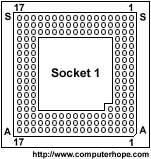 |
SOCKET 1 SPECIFICATIONS
| PINS |
PIN LAYOUT |
VOLTAGE |
SUPPORTED PROCESSORS |
| 169 Pins |
17 x 17 PGA |
5v |
SX / SX2, DX/DX2, DX4 OverDrive |
|
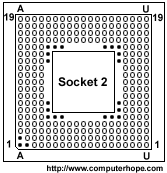 |
SOCKET 2 SPECIFICATIONS
| PINS |
PIN LAYOUT |
VOLTAGE |
SUPPORTED PROCESSORS |
| 238 |
19 x 19 PGA |
5v |
SX/SX2, DX/DX2, DX4 OverDrive, 486 Pentium OverDrive |
|
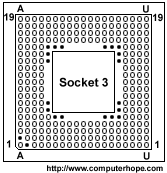 |
SOCKET 3 SPECIFICATIONS
| PINS |
PIN LAYOUT |
VOLTAGE |
SUPPORTED PROCESSORS |
| 237 |
19 x 19 PGA |
5v/3.3v |
SX/SX2, DX/DX2, DX4 OverDrive, 486 Pentium OverDrive |
|
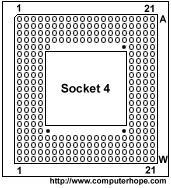 |
SOCKET 4 SPECIFICATIONS
| PINS |
PIN LAYOUT |
VOLTAGE |
SUPPORTED PROCESSORS |
| 273 |
21 x 21 PGA |
5v |
Pentium 60/66MHz, Pentium 60/66 OverDrive |
|
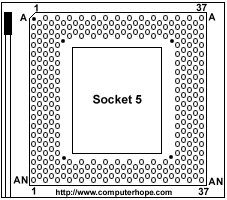 |
SOCKET 5 SPECIFICATIONS
| PINS |
PIN LAYOUT |
VOLTAGE |
SUPPORTED PROCESSORS |
| 320 |
37 x 37 PGA |
3.3v |
Pentium 75-133, Pentium 75+ OverDrive |
|
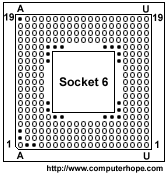 |
SOCKET 6 SPECIFICATIONS Slot 6 was
thought and planed of however was never actually ever implemented in any system.
| PINS |
PIN LAYOUT |
VOLTAGE |
SUPPORTED PROCESSORS |
| 235 |
19 x 19 PGA |
3.3v |
DX4, 486 Pentium OverDrive |
|
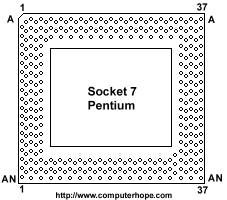 |
SOCKET 7 SPECIFICATIONS
| PINS |
PIN LAYOUT |
VOLTAGE |
SUPPORTED PROCESSORS |
| 321 |
37 x 37 PGA |
Voltage Regulator Module |
Pentium 75-300, Pentium 75+ OverDrive |
|
 |
SLOT 1 SPECIFICATIONS
| PINS |
PIN LAYOUT |
VOLTAGE |
SUPPORTED PROCESSORS |
| 242 |
Slot |
Voltage Regulator Module |
Pentium II / Pentium III Processors |
|
PROCESSOR HISTORY AND
INFORMATION
Below is a listing of all known manufacturers made to date. The following
list lists the processors manufactured in date order as well as a brief description of the
technology and advances of each of the processors.
INTEL 4004 - Microprocessor
introduced in 1970 with the speed of 108KHz was the worlds first microprocessor.
INTEL 8080 - Microprocessor
introduced in 1974 running at the speed of 2 MHz was used in the world's first PC, the
Altair.
INTEL 8086 (Code Name: P1)- Microprocessor
first introduced in 1976. The 80086 had a 16-bit architecture that allowed it to work with
16-bit binary numbers and pass them through a 16-bit data bus. The 8086 was available in
clock speeds of 5MHz, 8MHz, and 10MHz.
MOTOROLA 6800 - Microprocessor
released in 1979 was later chosen by Apple for the Macintosh computer.
INTEL 8087 - Floating-point math
compressor compliant with the 8086 / 8080 microprocessor family.
INTEL 8088 - Microprocessor
released in 1979. The 8088 was the first Processor used in the original IBM PC and XT
personal computers because it was less expensive than the 8086 microprocessor because of
the availability of less expensive eight-bit data bus supporting chips made it the
microprocessor for the IBM PC. The 8088 was available in speeds from 4.77 MHz and 8MHz.and
used the 16-bit architecture allowing it to work internally with 16-digit numbers. The
8088 had the ability of addressing up to 1MB of RAM.
INTEL 80286 (Code Name: P2) - Microprocessor
introduced by Intel in 1982. Which commonly is referred to as the 286 processor. The 286
processor supported 16-bit architecture, supported virtual memory, and was available in
clock speeds of 8MHz, 10MHz, and 12MHz. The 286 was around 20 times faster then the
predecessor 8088.
INTEL 80287 - A compliant processor
to the 286. A floating-point math coprocessor. Specially designed 286 chips have the
capability of placing the optional 80287 processor on top of it. Giving the computer a
math coprocessor.
INTEL 80386DX (Code Name: P3) - Microprocessor
manufactured in 1985 was the next generation of Intel processors. The 80386DX included the
math compressor unlike the 80386SX and still featured the 32-bit architecture and built-in
multitasking. The chip was available in clock speeds of 16MHz, 20MHz, 25MHz, and
33MHz.
SPARC - Released in 1987 is short for Scaleable Processor
ARChiture by Sun
- used RISC (Reduced Instruction Set) to speed up processing.
INTEL 80486DX (Code Name: P4) -
Microprocessor released April 10th 1989. The 486DX featured a built-in memory
cache and 32-bit architecture. It had more than three times the computing power of the
386DX and was available in clock speeds of 25MHz, 33MHz, and 50MHz.
INTEL 80386SX - Microprocessor
introduced in 1989 was the next generation of Intel processors. The 80386SX lacked a math
coprocessor however still featured the 32-bit architecture and built-in multitasking. The
chip was available in clock speeds of 16MHz, 20MHz, 25MHz, and 33MHz.
INTEL 80386SL - Microprocessor
introduced in 1990 which used low power consumption and was used mainly in portable
computers.
INTEL 80486SX (Code Name: P45 / P23
) - Microprocessor introduced in April 1991 which is a less expensive
version of the 80486DX. It lacked the math coprocessor of the 80486DX and ran at lower
clock speeds then the DX it ran at 16MHz, 20MHz, 25MHz, or 33 MHz.
INTEL 80486DX2 (Code Name: P24 / P24S)
- Microprocessor first introduced in March 2, 1992. It was based upon the popular
486DX however featured internal clock speeds that doubled that of the
system that operated it. Thus, a DX2 on a system with a 33MHz bus would run at 66MHz. Also
known as the i486DX2.
INTEL 80486DX4 (Code Name: P24C /
P24CT)- Microprocessor first introduced in 1994. The 486DX4 would triple
that of the system that operated it.
INTEL PENTIUM (Code Name: P5 (Pentium 60
- 66MHz))- Microprocessor introduced March 22, 1993 designed to replace the
486 processors. The new Pentium had an additional 1.9 million transistors when compared to
the 80486DX. The Pentium has a 32-bit address bus and a 64-bit data bus, and it can
operate at speeds of 60MHz to 200MHz. The Pentium was released in three generations. The
first-generation of Pentium processors was the Pentium 60 and 66 MHz. These chips used a
273-pin PGA form factor and ran on 5v power. Intel announced the release of a
second-generation introduced March 7, 1994 included new processors from 75, 90, 100, 120,
133, 150, 166, and 200 MHz. The processors used 296-pin SPGA form factor that is
physically incompatible with the first generation versions. The third-generation of
Pentium processors code named P55C were introduced January 1997, which incorporated
the new technology MMX. The Pentium MMX processors were available 166,
200, 233 MHz, and 266 MHz mobile version.
INTEL PENTIUM PRO (Code Name: P6) -
Microprocessor which was designed for the corporate users and for high-end
servers and workstations, preferably those using Windows NT. The Pentium Pro CPUs
are extremely fast with 32-bit applications and 3-D image processing and rendering when
compared to previous Intel processors. The chip runs at 166MHz and higher
INTEL PENTIUM II (Code Name: Klamath) -
Initially the Pentium II 233MHz was released in 1997 and introduced a new
physical architecture which encased a circuit board within a plastic case. With this new
technology this allowed the chip to be easily added and removed. However previous owners
of Pentium motherboard could not upgrade to this new type of chip unless the motherboard
they had included a SLOT 1 technology. The Pentium II runs from 233MHz to 450MHz.
INTEL PENTIUM III - Initially the
Pentium III 500 MHz was released in 1999 shortly after its released Intel introduced the
Pentium III 550 MHz processor. The Pentium III chip continued to use the SLOT 1 and could
be used on previous Pentium II motherboards with BIOS support. Before its release a big controversy concerning privacy. The Intel Pentium III chips have a ID for each chip
helping to authenticate peoples purchase over the Internet. However many argued that this
was another way for someone to find out personal information about the individual without
there consent. Intel disabled this feature by default and allowed it to be released after
released the chip.
|


